Abstract
Increased serum concentration of soluble alpha-chain receptor for interleukin-2 (sIL-2R) has been noted in patients with a variety of inflammatory conditions and lymphoid malignancies including T cell leukemia and lymphoma. Elevated sIL-2R serum levels seen in lymphoid malignancies appear to correlate with the clinical stage of disease. However, because sIL-2R is produced by normal activated lymphocytes, it has been uncertain whether serum sIL-2R in such conditions is derived from tumor cells or normal immune cells responding to the tumor. To address this question, we used a model of human (CD30+) anaplastic, large T cell lymphoma transplanted into immunodeficient SCID mice. Reverse transcription polymerase chain reaction of tumor RNA showed that the tumor, designated mJB6, contains mRNA for alpha-chain of human IL-2R. Furthermore, 15 to 25% of tumor cells stained with anti-human IL-2R alpha-chain mAb. Solid phase ELISA analysis of serum samples from mice bearing mJB6 lymphoma showed high concentrations of human sIL-2R. None of the control mice without lymphoma or with human nonlymphoid tumors (prostatic carcinoma, ovarian carcinoma, and glioblastoma multiforme) showed detectable human sIL-2R. The sIL-2R serum titers of mJB6-bearing mice correlated strongly with tumor volume (P < 0.0001). Tumors as small as 0.4 to 0.8 mm3 could be detected by this method. The sensitivity of sIL-2R ELISA exceeded at least 150 times the sensitivity of conventional radioisotopic tumor detection. Total resection of mJB6 tumors resulted in complete clearance of sIL-2R from the murine serum within 48 hours with a half-life of 6 hours. Accordingly, partial resection led to a significant decrease in sIL-2R followed by gradual increase with tumor regrowth. sIL-2R was also detected in the urine of mJB6-transplanted mice. As in serum, urine concentrations of sIL-2R were proportional to tumor mass (P < 0.02). Based on these findings we postulate that malignant cells are a major source of serum sIL-2R in patients with lymphoid tumors. In addition, our data further support monitoring sIL-2R concentration in body fluids as a sensitive method to detect change in tumor volume in such patients.
Full text
PDF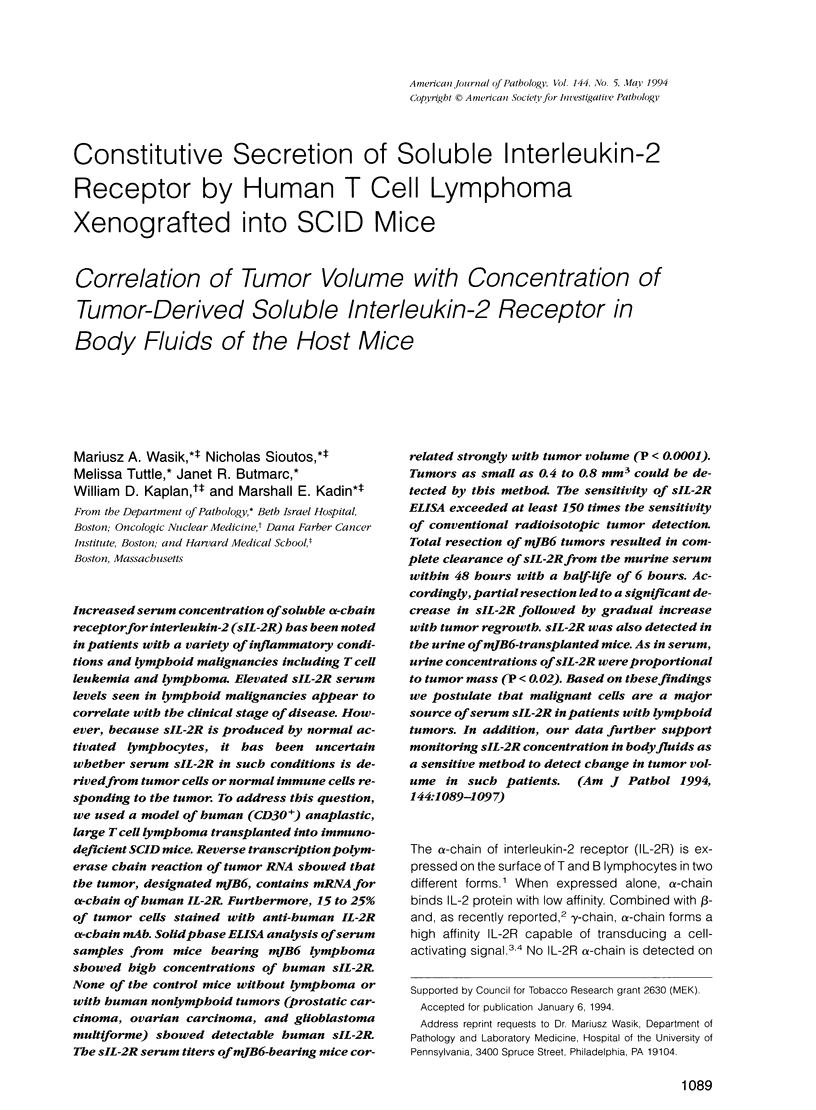

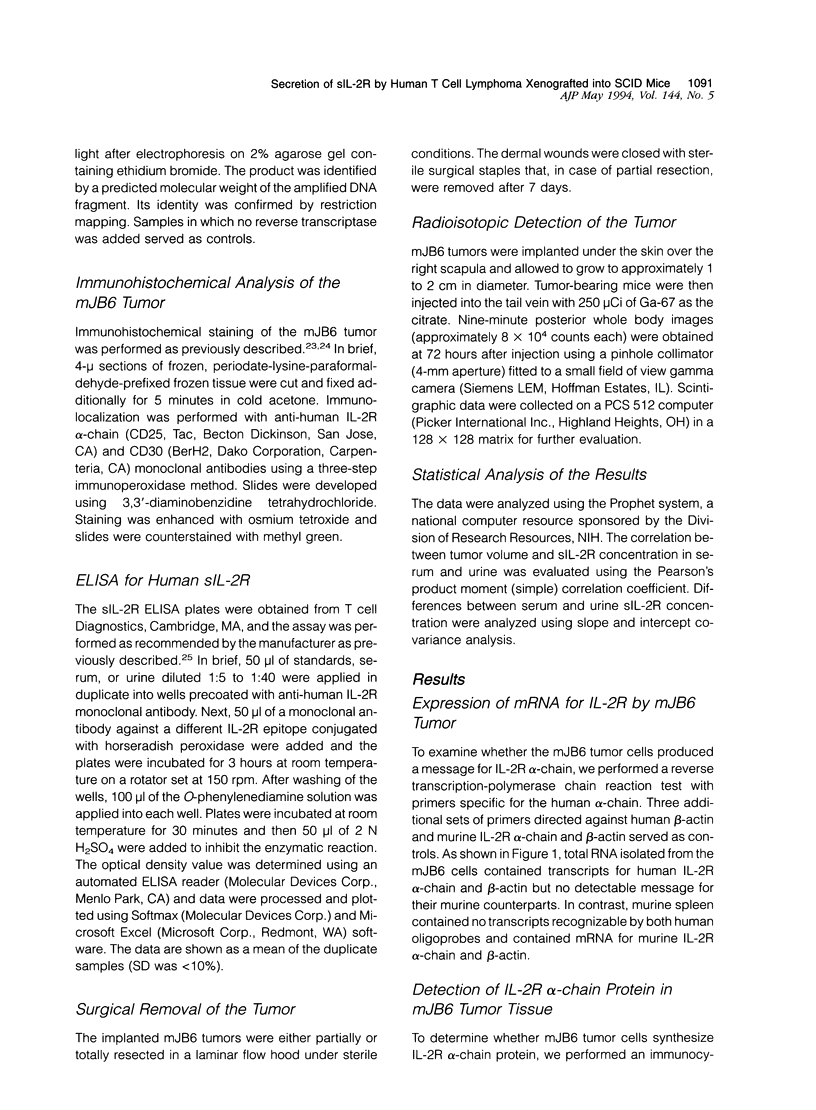
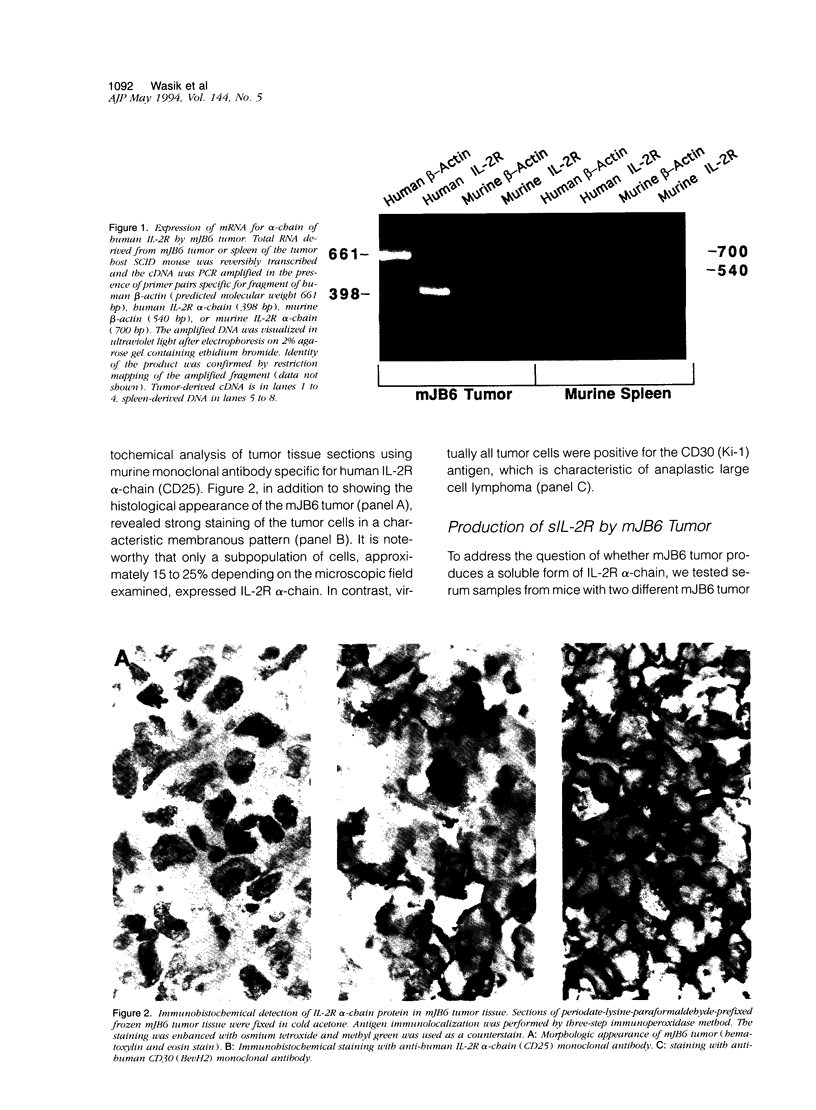
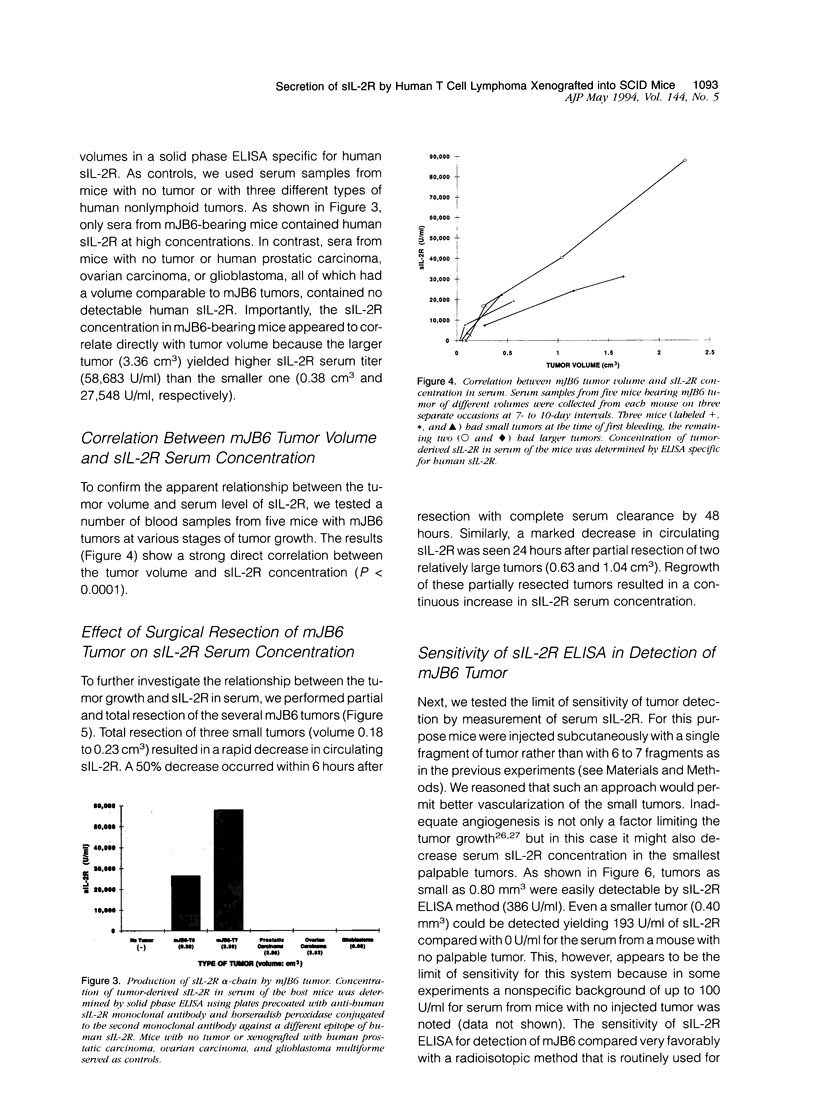

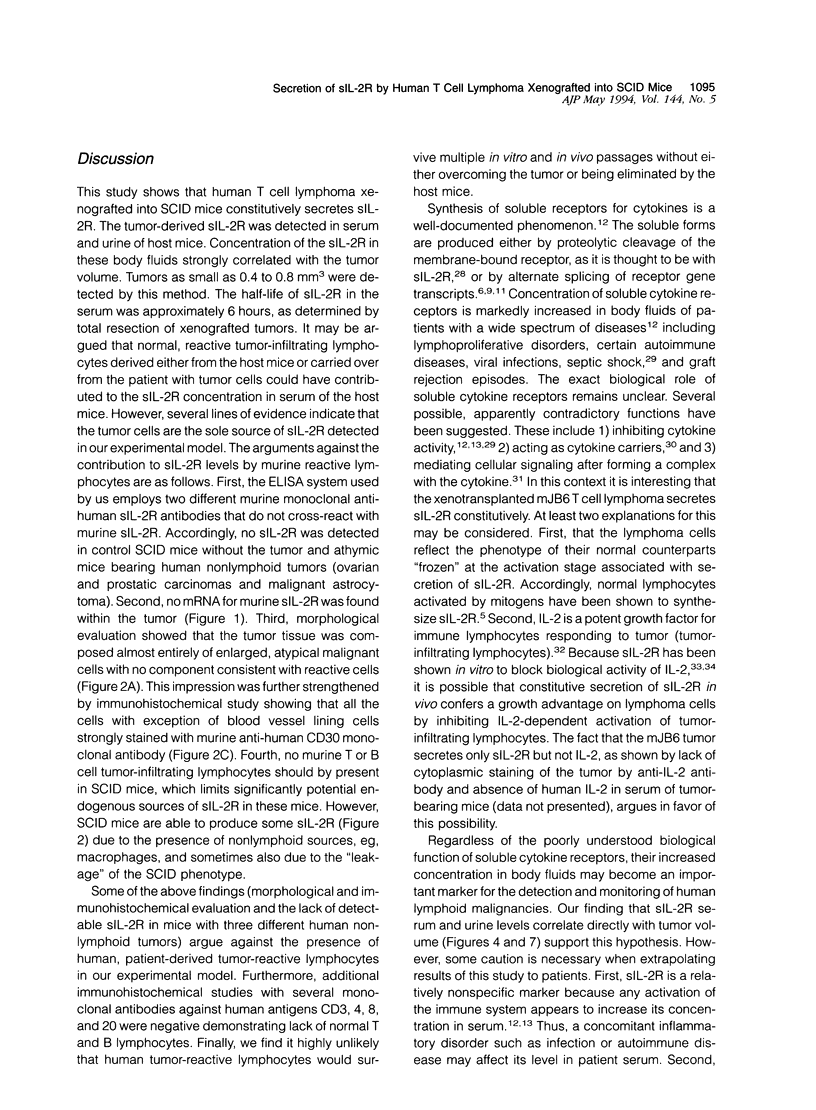
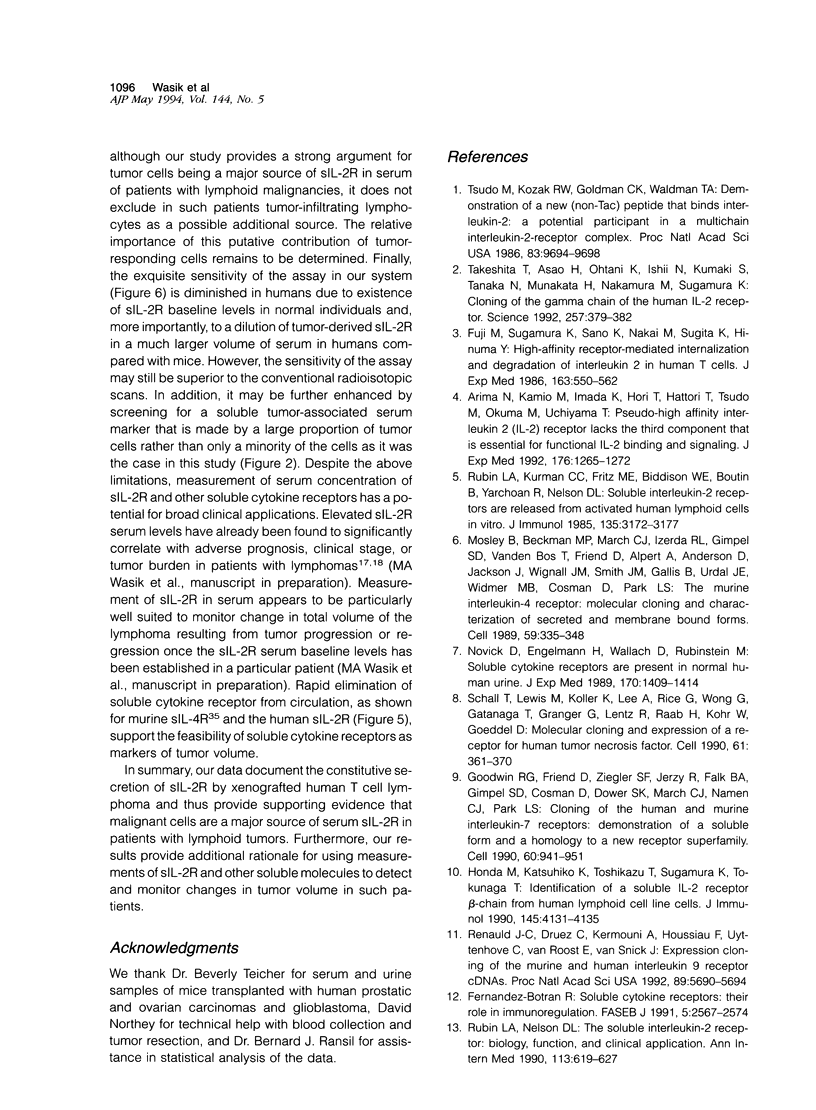
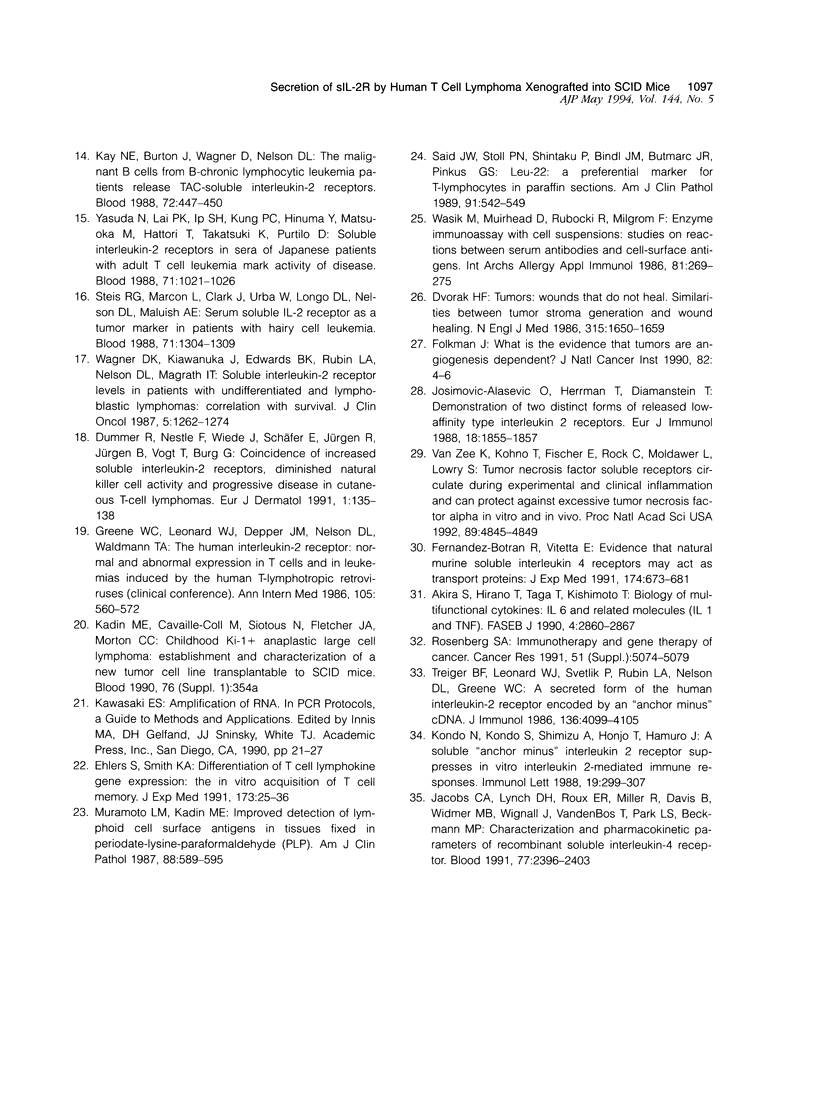
Images in this article
Selected References
These references are in PubMed. This may not be the complete list of references from this article.
- Akira S., Hirano T., Taga T., Kishimoto T. Biology of multifunctional cytokines: IL 6 and related molecules (IL 1 and TNF). FASEB J. 1990 Aug;4(11):2860–2867. [PubMed] [Google Scholar]
- Arima N., Kamio M., Imada K., Hori T., Hattori T., Tsudo M., Okuma M., Uchiyama T. Pseudo-high affinity interleukin 2 (IL-2) receptor lacks the third component that is essential for functional IL-2 binding and signaling. J Exp Med. 1992 Nov 1;176(5):1265–1272. doi: 10.1084/jem.176.5.1265. [DOI] [PMC free article] [PubMed] [Google Scholar]
- Dvorak H. F. Tumors: wounds that do not heal. Similarities between tumor stroma generation and wound healing. N Engl J Med. 1986 Dec 25;315(26):1650–1659. doi: 10.1056/NEJM198612253152606. [DOI] [PubMed] [Google Scholar]
- Ehlers S., Smith K. A. Differentiation of T cell lymphokine gene expression: the in vitro acquisition of T cell memory. J Exp Med. 1991 Jan 1;173(1):25–36. doi: 10.1084/jem.173.1.25. [DOI] [PMC free article] [PubMed] [Google Scholar]
- Fernandez-Botran R. Soluble cytokine receptors: their role in immunoregulation. FASEB J. 1991 Aug;5(11):2567–2574. doi: 10.1096/fasebj.5.11.1868981. [DOI] [PubMed] [Google Scholar]
- Fernandez-Botran R., Vitetta E. S. Evidence that natural murine soluble interleukin 4 receptors may act as transport proteins. J Exp Med. 1991 Sep 1;174(3):673–681. doi: 10.1084/jem.174.3.673. [DOI] [PMC free article] [PubMed] [Google Scholar]
- Folkman J. What is the evidence that tumors are angiogenesis dependent? J Natl Cancer Inst. 1990 Jan 3;82(1):4–6. doi: 10.1093/jnci/82.1.4. [DOI] [PubMed] [Google Scholar]
- Fujii M., Sugamura K., Sano K., Nakai M., Sugita K., Hinuma Y. High-affinity receptor-mediated internalization and degradation of interleukin 2 in human T cells. J Exp Med. 1986 Mar 1;163(3):550–562. doi: 10.1084/jem.163.3.550. [DOI] [PMC free article] [PubMed] [Google Scholar]
- Goodwin R. G., Friend D., Ziegler S. F., Jerzy R., Falk B. A., Gimpel S., Cosman D., Dower S. K., March C. J., Namen A. E. Cloning of the human and murine interleukin-7 receptors: demonstration of a soluble form and homology to a new receptor superfamily. Cell. 1990 Mar 23;60(6):941–951. doi: 10.1016/0092-8674(90)90342-c. [DOI] [PubMed] [Google Scholar]
- Greene W. C., Leonard W. J., Depper J. M., Nelson D. L., Waldmann T. A. The human interleukin-2 receptor: normal and abnormal expression in T cells and in leukemias induced by the human T-lymphotropic retroviruses. Ann Intern Med. 1986 Oct;105(4):560–572. doi: 10.7326/0003-4819-105-4-560. [DOI] [PubMed] [Google Scholar]
- Honda M., Kitamura K., Takeshita T., Sugamura K., Tokunaga T. Identification of a soluble IL-2 receptor beta-chain from human lymphoid cell line cells. J Immunol. 1990 Dec 15;145(12):4131–4135. [PubMed] [Google Scholar]
- Jacobs C. A., Lynch D. H., Roux E. R., Miller R., Davis B., Widmer M. B., Wignall J., VandenBos T., Park L. S., Beckmann M. P. Characterization and pharmacokinetic parameters of recombinant soluble interleukin-4 receptor. Blood. 1991 Jun 1;77(11):2396–2403. [PubMed] [Google Scholar]
- Josimovic-Alasevic O., Herrmann T., Diamantstein T. Demonstration of two distinct forms of released low-affinity type interleukin 2 receptors. Eur J Immunol. 1988 Nov;18(11):1855–1857. doi: 10.1002/eji.1830181133. [DOI] [PubMed] [Google Scholar]
- Kay N. E., Burton J., Wagner D., Nelson D. L. The malignant B cells from B-chronic lymphocytic leukemia patients release TAC-soluble interleukin-2 receptors. Blood. 1988 Aug;72(2):447–450. [PubMed] [Google Scholar]
- Kondo N., Kondo S., Shimizu A., Honjo T., Hamuro J. A soluble 'anchorminus' interleukin 2 receptor suppresses in vitro interleukin 2-mediated immune responses. Immunol Lett. 1988 Dec;19(4):299–307. doi: 10.1016/0165-2478(88)90159-9. [DOI] [PubMed] [Google Scholar]
- Mosley B., Beckmann M. P., March C. J., Idzerda R. L., Gimpel S. D., VandenBos T., Friend D., Alpert A., Anderson D., Jackson J. The murine interleukin-4 receptor: molecular cloning and characterization of secreted and membrane bound forms. Cell. 1989 Oct 20;59(2):335–348. doi: 10.1016/0092-8674(89)90295-x. [DOI] [PubMed] [Google Scholar]
- Muramoto L. M., Kadin M. E. Improved detection of lymphoid cell surface antigens in tissues fixed in periodate-lysine-paraformaldehyde (PLP). Am J Clin Pathol. 1987 Nov;88(5):589–595. doi: 10.1093/ajcp/88.5.589. [DOI] [PubMed] [Google Scholar]
- Novick D., Engelmann H., Wallach D., Rubinstein M. Soluble cytokine receptors are present in normal human urine. J Exp Med. 1989 Oct 1;170(4):1409–1414. doi: 10.1084/jem.170.4.1409. [DOI] [PMC free article] [PubMed] [Google Scholar]
- Renauld J. C., Druez C., Kermouni A., Houssiau F., Uyttenhove C., Van Roost E., Van Snick J. Expression cloning of the murine and human interleukin 9 receptor cDNAs. Proc Natl Acad Sci U S A. 1992 Jun 15;89(12):5690–5694. doi: 10.1073/pnas.89.12.5690. [DOI] [PMC free article] [PubMed] [Google Scholar]
- Rubin L. A., Kurman C. C., Fritz M. E., Biddison W. E., Boutin B., Yarchoan R., Nelson D. L. Soluble interleukin 2 receptors are released from activated human lymphoid cells in vitro. J Immunol. 1985 Nov;135(5):3172–3177. [PubMed] [Google Scholar]
- Rubin L. A., Nelson D. L. The soluble interleukin-2 receptor: biology, function, and clinical application. Ann Intern Med. 1990 Oct 15;113(8):619–627. doi: 10.7326/0003-4819-113-8-619. [DOI] [PubMed] [Google Scholar]
- Said J. W., Stoll P. N., Shintaku P., Bindl J. M., Butmarc J. R., Pinkus G. S. Leu-22: a preferential marker for T-lymphocytes in paraffin sections. Staining profile in T- and B-cell lymphomas, Hodgkin's disease, other lymphoproliferative disorders, myeloproliferative diseases, and various neoplastic processes. Am J Clin Pathol. 1989 May;91(5):542–549. doi: 10.1093/ajcp/91.5.542. [DOI] [PubMed] [Google Scholar]
- Schall T. J., Lewis M., Koller K. J., Lee A., Rice G. C., Wong G. H., Gatanaga T., Granger G. A., Lentz R., Raab H. Molecular cloning and expression of a receptor for human tumor necrosis factor. Cell. 1990 Apr 20;61(2):361–370. doi: 10.1016/0092-8674(90)90816-w. [DOI] [PubMed] [Google Scholar]
- Steis R. G., Marcon L., Clark J., Urba W., Longo D. L., Nelson D. L., Maluish A. E. Serum soluble IL-2 receptor as a tumor marker in patients with hairy cell leukemia. Blood. 1988 May;71(5):1304–1309. [PubMed] [Google Scholar]
- Takeshita T., Asao H., Ohtani K., Ishii N., Kumaki S., Tanaka N., Munakata H., Nakamura M., Sugamura K. Cloning of the gamma chain of the human IL-2 receptor. Science. 1992 Jul 17;257(5068):379–382. doi: 10.1126/science.1631559. [DOI] [PubMed] [Google Scholar]
- Treiger B. F., Leonard W. J., Svetlik P., Rubin L. A., Nelson D. L., Greene W. C. A secreted form of the human interleukin 2 receptor encoded by an "anchor minus" cDNA. J Immunol. 1986 Jun 1;136(11):4099–4105. [PubMed] [Google Scholar]
- Tsudo M., Kozak R. W., Goldman C. K., Waldmann T. A. Demonstration of a non-Tac peptide that binds interleukin 2: a potential participant in a multichain interleukin 2 receptor complex. Proc Natl Acad Sci U S A. 1986 Dec;83(24):9694–9698. doi: 10.1073/pnas.83.24.9694. [DOI] [PMC free article] [PubMed] [Google Scholar]
- Van Zee K. J., Kohno T., Fischer E., Rock C. S., Moldawer L. L., Lowry S. F. Tumor necrosis factor soluble receptors circulate during experimental and clinical inflammation and can protect against excessive tumor necrosis factor alpha in vitro and in vivo. Proc Natl Acad Sci U S A. 1992 Jun 1;89(11):4845–4849. doi: 10.1073/pnas.89.11.4845. [DOI] [PMC free article] [PubMed] [Google Scholar]
- Wagner D. K., Kiwanuka J., Edwards B. K., Rubin L. A., Nelson D. L., Magrath I. T. Soluble interleukin-2 receptor levels in patients with undifferentiated and lymphoblastic lymphomas: correlation with survival. J Clin Oncol. 1987 Aug;5(8):1262–1274. doi: 10.1200/JCO.1987.5.8.1262. [DOI] [PubMed] [Google Scholar]
- Wasik M., Muirhead D., Rubocki R., Milgrom F. Enzyme immunoassay with cell suspensions: studies on reactions between serum antibodies and cell-surface antigens. Int Arch Allergy Appl Immunol. 1986;81(3):269–275. doi: 10.1159/000234146. [DOI] [PubMed] [Google Scholar]
- Yasuda N., Lai P. K., Ip S. H., Kung P. C., Hinuma Y., Matsuoka M., Hattori T., Takatsuki K., Purtilo D. T. Soluble interleukin 2 receptors in sera of Japanese patients with adult T cell leukemia mark activity of disease. Blood. 1988 Apr;71(4):1021–1026. [PubMed] [Google Scholar]




